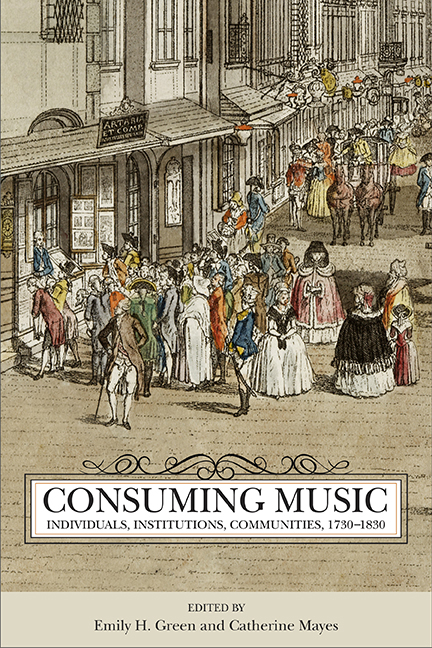Book contents
- Frontmatter
- Contents
- Acknowledgments
- Introduction
- Part One Selling Variety
- 1 Music's First Consumers: Publishers in the Late Eighteenth Century
- 2 Inside a Viennese Kunsthandlung: Artaria in 1784
- Part Two Edifying Readers
- Part Three Marketing the Mundane
- Part Four Cultivating Communities
- List of Contributors
- Index
1 - Music's First Consumers: Publishers in the Late Eighteenth Century
from Part One - Selling Variety
Published online by Cambridge University Press: 26 April 2018
- Frontmatter
- Contents
- Acknowledgments
- Introduction
- Part One Selling Variety
- 1 Music's First Consumers: Publishers in the Late Eighteenth Century
- 2 Inside a Viennese Kunsthandlung: Artaria in 1784
- Part Two Edifying Readers
- Part Three Marketing the Mundane
- Part Four Cultivating Communities
- List of Contributors
- Index
Summary
In a Prague newspaper's assessment of culture in the Rheinland in 1820, Johann Anton André stands out as the prime merit of Offenbach: “[In Offenbach], nothing interests me more than André, the famous lithographer, the famous composer, the famous virtuoso, the famous music-printer, who is also, in addition to [having] many good qualities, a very pleasant associate [Gesellschafter] and a very cultured man.” For the writer, André is an exemplary citizen of the greater Frankfurt area. Not only is the music publisher competent in his professional capacity as a lithographer, he is also worthy of praise in a host of other surprising ways. He is hailed as a composer, virtuoso (presumably as a performer, as André came from a family of musicians), and generally educated member of society. While publishers were rarely afforded any descriptive adjectives as individuals in the press, here André is painted as a skilled and well rounded person. Inasmuch as it praises André for his fame and character, this short passage recalls the language used to describe patrons in dedications of the mid- to late eighteenth century.
Around the same time, and following in the tradition of his predecessors and contemporaries, André issued a catalog of wares (fig. 1.1)—a document that presented his activities as a publisher somewhat differently. Printed on the back of the title page of a violin concerto by C. F. LaFont, the list demonstrates a thoughtful, thorough, and possibly excessive hand at collecting, advertising many genres of interest to an individual who might purchase a string concerto and demonstrating a careful alphabetic approach to each category. The depth and breadth of the offerings within a limited range of string genres—including sonatas, duos, quartets, quintets, concertos, works for orchestra, etudes, and cello works—seem designed to demonstrate the publisher's versatility and taste. In fact, one could argue that the list was intended to highlight those qualities explicitly: the catalog is a public display of André's habits in acquiring new music, and thus it is a conspicuous record of the firm's purchasing power.
- Type
- Chapter
- Information
- Consuming MusicIndividuals, Institutions, Communities, 1730–1830, pp. 13 - 28Publisher: Boydell & BrewerPrint publication year: 2017

